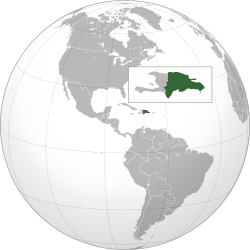Not to be confused with Dominica.
| Dominican Republic República Dominicana (Spanish) | ||||||
|---|---|---|---|---|---|---|
| ||||||
| Motto: "Dios, Patria, Libertad" (Spanish) ("God, Fatherland, Liberty") | ||||||
| Anthem: Himno Nacional | ||||||
| Capital (and largest city) | Santo Domingo 19°00′N 70°40′W / 19°N 70.667°W | |||||
| Official language(s) | Spanish | |||||
| Ethnic groups | 73% Mixed, 16% White, 11% Black[1] | |||||
| Demonym | Dominican | |||||
| Government | Democratic Republic[1][2] or Representative Democracy[2] | |||||
| - | President | Leonel Fernández[2] | ||||
| - | Vice President | Rafael Alburquerque[2] | ||||
| Independence | From Spain: | |||||
| - | Date | December 1, 1821[2] | ||||
| - | Date | From Haiti: February 27, 1844[2] | ||||
| - | Date | From Spain: August 16, 1865[2] | ||||
| Area | ||||||
| - | Total | 48,442 km2 (130th) 18,704 sq mi | ||||
| - | Water (%) | 0.7[1] | ||||
| Population | ||||||
| - | 2009 estimate | 10,090,000[3] (80th) | ||||
| - | 2002 census | 8,562,541[4] | ||||
| - | Density | 208.2/km2 (57th) 539.4/sq mi | ||||
| GDP (PPP) | 2009 estimate | |||||
| - | Total | $80.339 billion[5] | ||||
| - | Per capita | $8,896[5] | ||||
| GDP (nominal) | 2009 estimate | |||||
| - | Total | $46.743 billion[5] | ||||
| - | Per capita | $5,176[5] | ||||
| Gini (2005) | 49.9[1] (high) | |||||
| HDI (2007) | ▲ 0.777[6] (medium) (90th) | |||||
| Currency | Peso[2] (DOP) | |||||
| Time zone | Atlantic (UTC-4[1]) | |||||
| Drives on the | right | |||||
| Internet TLD | .do[1] | |||||
| Calling code | +1-809, +1-829, +1-849 | |||||
| Sources for: | ||||||
Inhabited by Taínos since the seventh century, the territory of the Dominican Republic was reached by Christopher Columbus in 1492 and became the site of the first permanent European settlement in the Americas, namely Santo Domingo, the country's capital and Spain's first capital in the New World. In Santo Domingo stand, among other firsts in the Americas, the first university, cathedral, and castle, the latter two in the Ciudad Colonial area, a UNESCO World Heritage Site.[2][8]
After three centuries of Spanish rule, with French and Haitian interludes, the country became independent in 1821 but was quickly taken over by Haiti. Victorious in the Dominican War of Independence in 1844, Dominicans experienced mostly political turmoil and a brief return to Spanish rule over the next 72 years. The United States occupation of 1916–1924, and a subsequent, calm and prosperous six-year period under Horacio Vásquez Lajara, were followed by the dictatorship of Rafael Leonidas Trujillo Molina until 1961. The civil war of 1965, the country's last, was ended by a U.S.-led intervention, and was followed by the authoritarian rule of Joaquín Balaguer, 1966 – 1978. Since then, the Dominican Republic has moved toward representative democracy,[1] and has been led by Leonel Fernández for most of the time after 1996.
The Dominican Republic has the second largest economy in the Caribbean.[9][10] Though long known for sugar production, the economy is now dominated by services.[1] The country's economic progress is exemplified by its advanced telecommunication system.[11] Nevertheless, unemployment,[1] government corruption, and inconsistent electric service remain major Dominican problems. The country also has "marked income inequality".[1]
International migration greatly affects the country, as it receives and sends large flows of migrants. Haitian immigration and the integration of Dominicans of Haitian descent are major issues; the total population of Haitian origin is estimated to be 800,000.[12] A large Dominican diaspora exists, most of it in the United States, where it comprises 1.3 million.[13] They aid national development as they send billions of dollars to their families, accounting for one-tenth of the Dominican GDP.[1][14]
The Dominican Republic has become the Caribbean's largest tourist destination; the country's year-round golf courses are among the top attractions.[11] In this mountainous land is located the Caribbean's highest mountain, Pico Duarte, as is Lake Enriquillo, the Caribbean's largest lake and lowest elevation.[15] Quisqueya, as Dominicans often call their country, has an average temperature of 26 °C (78.8 °F) and great biological diversity.[11]
Music and sport are of the highest importance in Dominican culture, with merengue as the national dance and song and baseball the favorite sport.[2]




Δεν υπάρχουν σχόλια:
Δημοσίευση σχολίου